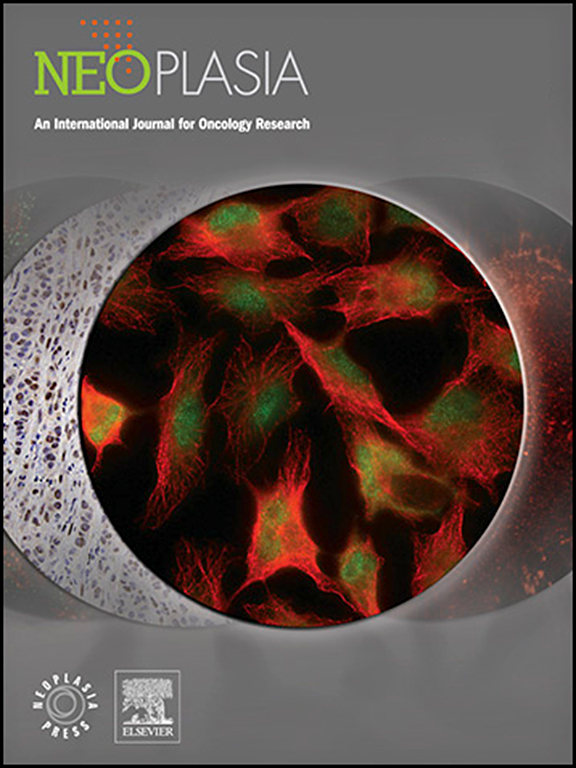Generation of orthotopic intracranial glioblastoma patient-derived xenograft models: insights into extrachromosomal DNA-driven MYC(N) and PDGFRA oncogene amplification and preliminary therapeutic evaluation
IF 7.7
2区 医学
Q1 Biochemistry, Genetics and Molecular Biology
引用次数: 0
Abstract
Background
This study aimed to establish orthotopic intracranial patient-derived xenograft (PDX) models to investigate molecular and pathological features and to evaluate potential preclinical therapeutic approaches in glioblastoma (GBM).
Methods
Fresh or cryopreserved patient tumor tissues were first expanded as subcutaneous PDXs and subsequently used to generate orthotopic intracranial PDXs. Tumor growth and similarity to patient tumors were assessed by magnetic resonance imaging (MRI), pathological analyses, and multi-omics profiling. A selected intracranial PDX was further used to evaluate the potential preclinical efficacy of natural killer (NK) cells combined with Avastin® and irinotecan. The cytotoxic effects of this combination were also examined in primary GBM cells obtained from the original tumor of the same PDX.
Results
Subcutaneous PDX engraftment was successful in 13 out of 16 cases (81.3 %), and orthotopic intracranial PDXs were established from six of these with a 100 % success rate. Subcutaneous tumors expanded within 9 to 31 weeks, while intracranial tumors formed within 4 to 14 weeks. Subcutaneous growth was influenced by the Ki-67 index and the cryopreservation duration. Multi-omics analysis revealed extrachromosomal DNA (ecDNA)-driven amplifications of MYC(N), PDGFRA, CDK4, and MDM2 in PDXs from two patients. PDGFRA, CDK4, and MDM2 amplifications were consistent with those in the primary tumors, whereas MYC(N) amplification, initially minimal or absent in patient samples, was markedly enriched in the PDXs. Of the multiple PDXs from a single patient, the one PDX harboring ecDNA-driven MYCN amplification showed a greatly accelerated growth rate. Notably, PDXs containing ecDNA-driven MYC amplification exhibited a histological transformation toward primitive embryonal features. Combining NK cells with Avastin® and irinotecan enhanced cytotoxicity in vitro and prolonged survival in intracranial PDXs harboring ecDNA-driven MYC and PDGFRA amplifications.
Conclusion
Intracranial PDX models were successfully established from cryopreserved GBM tissues through subcutaneous expansion. These models offer a clinically relevant platform for investigating GBM biology and evaluating the therapeutic efficacy of chemoimmunotherapy.
原位颅内胶质母细胞瘤患者来源的异种移植模型的产生:染色体外dna驱动的MYC(N)和PDGFRA癌基因扩增和初步治疗评估的见解
本研究旨在建立原位颅内患者来源的异种移植物(PDX)模型,以研究胶质母细胞瘤(GBM)的分子和病理特征,并评估潜在的临床前治疗方法。方法新鲜或冷冻保存的患者肿瘤组织首先扩增为皮下pdx,然后用于生成原位颅内pdx。通过磁共振成像(MRI)、病理分析和多组学分析评估肿瘤生长和与患者肿瘤的相似性。选择颅内PDX进一步评估自然杀伤(NK)细胞联合阿瓦斯汀®和伊立替康的潜在临床前疗效。这种组合的细胞毒性作用也在同一PDX的原始肿瘤中获得的原代GBM细胞中进行了检查。结果16例患者中有13例(81.3%)成功皮下植入PDX,其中6例植入原位颅内PDX,成功率为100%。皮下肿瘤在9 ~ 31周内扩大,颅内肿瘤在4 ~ 14周内形成。皮下生长受Ki-67指数和低温保存时间的影响。多组学分析显示,在两名患者的pdx中,染色体外DNA (ecDNA)驱动的MYC(N)、PDGFRA、CDK4和MDM2扩增。PDGFRA、CDK4和MDM2扩增与原发肿瘤中的扩增一致,而MYC(N)扩增在患者样本中最初很少或不存在,但在pdx中明显富集。在来自单个患者的多个PDX中,含有ecdna驱动的MYCN扩增的PDX的生长速度大大加快。值得注意的是,含有ecdna驱动的MYC扩增的pdx表现出向原始胚胎特征的组织学转变。NK细胞与阿瓦斯汀和伊立替康联合使用可增强体外细胞毒性,延长携带ecdna驱动的MYC和PDGFRA扩增的颅内pdx的存活时间。结论低温保存的GBM组织经皮下扩张成功建立颅内PDX模型。这些模型为研究GBM生物学和评估化学免疫治疗的疗效提供了临床相关的平台。
本文章由计算机程序翻译,如有差异,请以英文原文为准。
求助全文
约1分钟内获得全文
求助全文
来源期刊

Neoplasia
医学-肿瘤学
CiteScore
9.20
自引率
2.10%
发文量
82
审稿时长
26 days
期刊介绍:
Neoplasia publishes the results of novel investigations in all areas of oncology research. The title Neoplasia was chosen to convey the journal’s breadth, which encompasses the traditional disciplines of cancer research as well as emerging fields and interdisciplinary investigations. Neoplasia is interested in studies describing new molecular and genetic findings relating to the neoplastic phenotype and in laboratory and clinical studies demonstrating creative applications of advances in the basic sciences to risk assessment, prognostic indications, detection, diagnosis, and treatment. In addition to regular Research Reports, Neoplasia also publishes Reviews and Meeting Reports. Neoplasia is committed to ensuring a thorough, fair, and rapid review and publication schedule to further its mission of serving both the scientific and clinical communities by disseminating important data and ideas in cancer research.
 求助内容:
求助内容: 应助结果提醒方式:
应助结果提醒方式:


